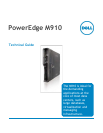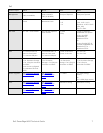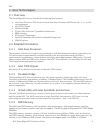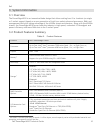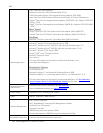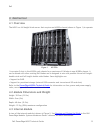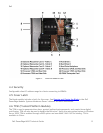
Dell
Dell PowerEdge M910 Technical Guide 8
2 New Technologies
2.1 Overview
The PowerEdge M910 server includes the following new features:
Intel Xeon Processor 7500 Series (4s) and Intel Xeon Processor 6500 Series (2s) 4-, 6-, and 8-
core processors
Intel 7500 Chipset
FlexMem Bridge
IO Hub (IOH) with Intel
®
QuickPath Architecture
DDR3 memory
PCI Express
®
Generation 2
Optional Redundant SD media for embedded hypervisor
iDRAC6 Express
2.2 Detailed Information
2.2.1 Intel Xeon Processors
The processor features up to eight-core processing to with maximize performance (expected up to
3.8x performance improvements) and performance/watt and significant energy efficiency
improvements for datacenter infrastructures and highly dense deployments. Additionally, the Intel
Xeon processor 6500 and 7500 series features the Intel
®
64 Architecture for flexibility in 64-bit and
32-bit applications and operating systems.
2.2.2 Intel 7500 Chipset
See Section 8 for detailed information in the Intel 7500 chipset.
2.2.3 FlexMem Bridge
The PowerEdge M910 also introduces a new, Dell patent-pending, technology which will allow
flexibility in processor and memory scalability—FlexMem Bridge. The FlexMem Bridge allows the full
amount of addressable DIMMs on 4-Socket systems with Intel Xeon processor 7500 and 6500 series to
be accessed, even when only 2 of the processors are in place, in a completely passive solution (no
active components).
2.2.4 IO Hub (IOH) with Intel QuickPath Architecture
The Intel QuickPath Architecture consists of serial point-to-point interconnects for the processors
and the system IOH. The M910 has a total of eight QuickPath Interconnects (QPI) lines: six links
connecting the processors and two links connection processors 1 and 2 with the IOH.
2.2.5 DDR3 Memory
The M910 uses DDR3 memory which provides a high-performance, high-speed memory interface
capable of low latency response and high throughput. The M910 supports Registered ECC DDR3 DIMMs
(RDIMMs).
The DDR3 memory interface consists of 8 Intel Scalable Memory Buffers (SMBs), each or which has
two DDR3 memory channels. Each channel supports up to two RDIMMs for single/dual/quad rack. By
limiting to two DIMMs per DDR channel, the system can support quad-rank DIMMs at 1067MHz.



